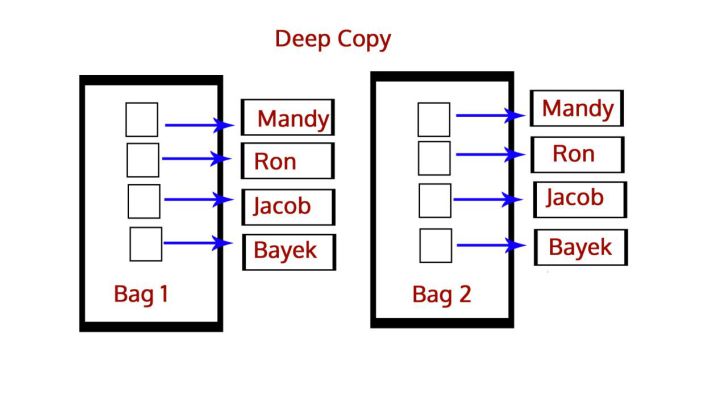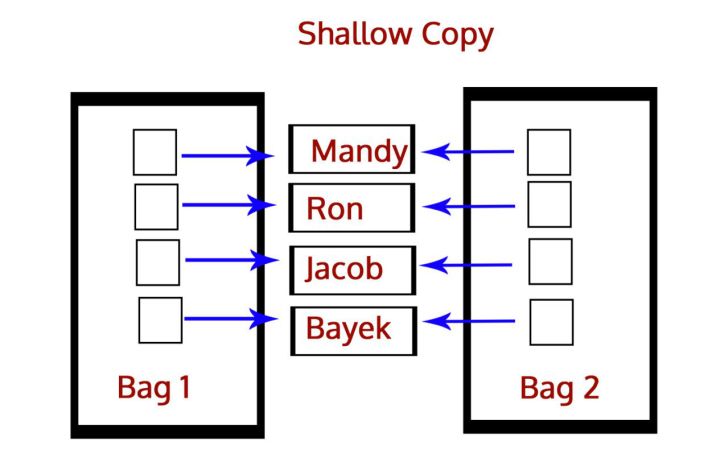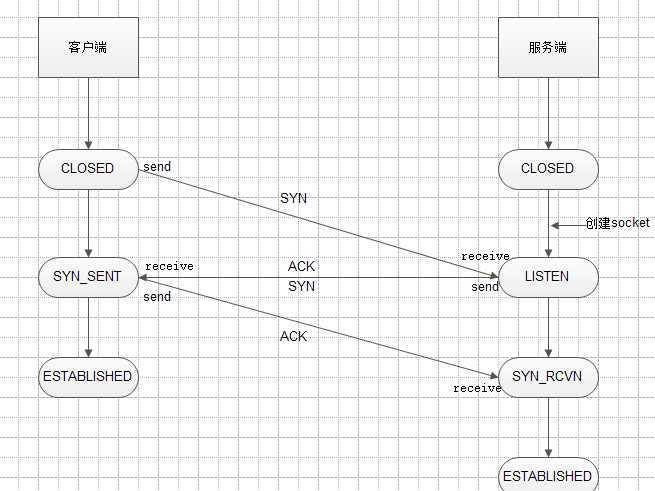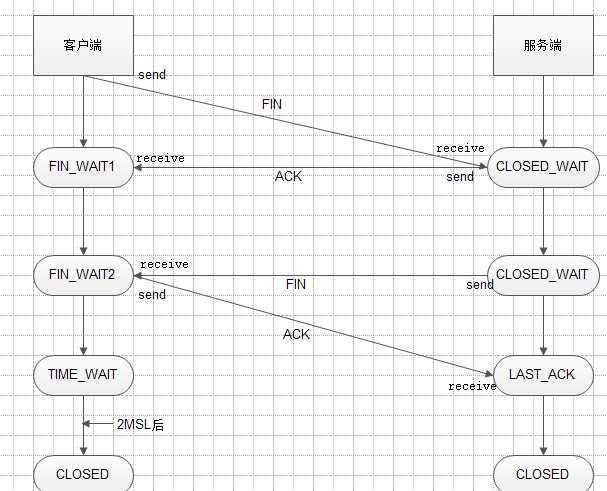浅copy与deepcopy

深浅拷贝之间的区别?
import copy b=copy.deepcopy(a)

b=copy.copy(a)

可变与不可变
copy.copy() # 浅拷贝 copy.deepcopy() # 深拷贝
引计数
标记-清除

分代回收
TCP协议
UDP协议
三次握手

三次握手过程说明
四次挥手

四次挥手过程说明
11种状态


由于TCP连接是全双工的,断开连接会比建立连接麻烦一点点。
CLOSING状态表示:

LISTEN --------------- # 等待从任何远端TCP 和端口的连接请求。 SYN_SENT ----------- # 发送完一个连接请求后等待一个匹配的连接请求。 SYN_RECEIVED ------ # 发送连接请求并且接收到匹配的连接请求以后等待连接请求确认。 ESTABLISHED -------- # 表示一个打开的连接,接收到的数据可以被投递给用户。连接的数据传输阶段的正常状态。 FIN_WAIT_1 ----------- # 等待远端TCP 的连接终止请求,或者等待之前发送的连接终止请求的确认。 FIN_WAIT_2 ---------- # 等待远端TCP 的连接终止请求。 CLOSE_WAIT --------- # 等待本地用户的连接终止请求。 CLOSING ------------- # 等待远端TCP 的连接终止请求确认。 LAST_ACK ------------ # 等待先前发送给远端TCP 的连接终止请求的确认(包括它字节的连接终止请求的确认) TIME_WAIT ----------- # 等待足够的时间过去以确保远端TCP 接收到它的连接终止请求的确认。 CLOSED --------------- # 不在连接状态(这是为方便描述假想的状态,实际不存在)
TIME_WAIT 两个存在的理由:

>>> def f(s): ... return s.title() ... >>> l = map(f, [‘pYthon‘, ‘jaVa‘, ‘kOtlin‘]) >>> list(l) [‘Python‘, ‘Java‘, ‘Kotlin‘]

lists= [11,22,33,44,55] ret = map(lambda x:x if x % 2 != 0 else x + 100,lists) print(list(ret)) # 运行结果: [11, 122, 33, 144, 55]

lists= [11,22,33,44,55] def add(num): if num%2 == 0: return num else: return num + 100 rs = map(add, lists)

# 例如有一个list,里边的元素都是字符串,要把它拼接成一个字符串: >>> from functools import reduce >>> def f(x, y): ... return x + y ... >>> reduce(f, [‘ab‘, ‘c‘, ‘de‘, ‘f‘]) ‘abcdef‘

from functools import reduce def f(x, y): return x + y print(reduce(f, [1, 3, 5, 7, 9])) # 25 # 1、先计算头两个元素:f(1, 3),结果为4; # 2、再把结果和第3个元素计算:f(4, 5),结果为9; # 3、再把结果和第4个元素计算:f(9, 7),结果为16; # 4、再把结果和第5个元素计算:f(16, 9),结果为25; # 5、由于没有更多的元素了,计算结束,返回结果25。 print( reduce(lambda x, y: x + y, [1, 3, 5, 7, 9]) ) # 25

‘‘‘使用reduce将字符串反转‘‘‘ s = ‘Hello World‘ from functools import reduce result = reduce(lambda x,y:y+x,s) # 1、第一次:x=H,y=e => y+x = eH # 2、第二次:x=l,y=eH => y+x = leH # 3、第三次:x=l,y=leH => y+x = lleH print( result ) # dlroW olleH

例如一个list中元素有纯字母、纯数字、字母数字组合的,我们要保留纯字母的: >>> def f(s): ... return s.isalpha() ... >>> l = filter(f, [‘abc‘, ‘xyz‘, ‘123kg‘, ‘666‘]) >>> list(l) [‘abc‘, ‘xyz‘]

>>> sorted([6, -2, 4, -1]) [-2, -1, 4, 6] >>> sorted([6, -2, 4, -1], key=abs) [-1, -2, 4, 6] >>> sorted([6, -2, 4, -1], key=abs, reverse=True) [6, 4, -2, -1] >>> sorted([‘Windows‘, ‘iOS‘, ‘Android‘]) [‘Android‘, ‘Windows‘, ‘iOS‘] >>> d = [(‘Tom‘, 170), (‘Jim‘, 175), (‘Andy‘, 168), (‘Bob‘, 185)] >>> def by_height(t): ... return t[1] ... >>> sorted(d, key=by_height) [(‘Andy‘, 168), (‘Tom‘, 170), (‘Jim‘, 175), (‘Bob‘, 185)]
sorted和sort区别
sorted使用

students = [(‘john‘, ‘A‘, 15), (‘jane‘, ‘B‘, 12), (‘dave‘, ‘B‘, 10)] print( sorted(students, key=lambda s: s[2], reverse=False) ) # 按年龄排序 # 结果:[(‘dave‘, ‘B‘, 10), (‘jane‘, ‘B‘, 12), (‘john‘, ‘A‘, 15)]

d = {‘k1‘:1, ‘k3‘: 3, ‘k2‘:2}
# d.items() = [(‘k1‘, 1), (‘k3‘, 3), (‘k2‘, 2)]
a = sorted(d.items(), key=lambda x: x[1])
print(a) # [(‘k1‘, 1), (‘k2‘, 2), (‘k3‘, 3)]

>>> a = ‘cheesezh‘ >>> b = ‘cheesezh‘ >>> a == b True

>>> x = y = [4,5,6] >>> z = [4,5,6] >>> x == y True >>> x == z True >>> x is y True >>> x is z False >>> >>> print id(x) 3075326572 >>> print id(y) 3075326572 >>> print id(z) 3075328140
下面再来看一个例子,例3中同一类型下的a和b的(a==b)都是为True,而(a is b)则不然。

>>> a = 1 #a和b为数值类型 >>> b = 1 >>> a is b True >>> id(a) 14318944 >>> id(b) 14318944 >>> a = ‘cheesezh‘ #a和b为字符串类型 >>> b = ‘cheesezh‘ >>> a is b True >>> id(a) 42111872 >>> id(b) 42111872 >>> a = (1,2,3) #a和b为元组类型 >>> b = (1,2,3) >>> a is b False >>> id(a) 15001280 >>> id(b) 14790408 >>> a = [1,2,3] #a和b为list类型 >>> b = [1,2,3] >>> a is b False >>> id(a) 42091624 >>> id(b) 42082016 >>> a = {‘cheese‘:1,‘zh‘:2} #a和b为dict类型 >>> b = {‘cheese‘:1,‘zh‘:2} >>> a is b False >>> id(a) 42101616 >>> id(b) 42098736 >>> a = set([1,2,3])#a和b为set类型 >>> b = set([1,2,3]) >>> a is b False >>> id(a) 14819976 >>> id(b) 14822256
通过例3可看出,只有数值型和字符串型的情况下,a is b才为True,当a和b是tuple,list,dict或set型时,a is b为False。
open函数用来打开文件

with open("data1.txt",‘r‘,encoding = ‘utf-8‘) as f: for line in f: print(line)
三种读操作比较

#1. read()一次读取所有内容 ‘‘‘aaa111 bbb222‘‘‘ f = open(r"data.txt") print(f.read()) f.close() #2. readline(),每次只读取一行,光标下移 ‘‘‘ 0: aaa111 1: bbb222 ‘‘‘ f = open(r"data.txt") for i in range(2): print(str(i) + ": " + f.readline(),) #3. 一次读取所有,每行作为列表的一个值 ‘‘‘[‘aaa111\n‘, ‘bbb222\n‘]‘‘‘ f = open(r"data.txt") print(f.readlines())
读取大文件正确方式

#!/usr/bin/python # -*- coding: utf-8 -*- def read_big_file_v(fname): block_size = 1024 * 8 with open(fname,encoding="utf8") as fp: while True: chunk = fp.read(block_size) # 当文件没有更多内容时,read 调用将会返回空字符串 ‘‘ if not chunk: break print(chunk) path = r‘C:\aaa\luting\edc-backend\tttt.py‘ read_big_file_v(path)
使用read()读文件

f = open(r"somefile.txt") print(f.read(7)) # Welcome 先读出 7 个字符 print(f.read(4)) #‘ to ‘ 接着上次读出 4 个字符 f.close()

f = open(r"somefile.txt", "w") f.write("01234567890123456789") f.seek(5) f.write("Hello, World!") f.close() f = open(r"somefile.txt") print(f.read()) # 01234Hello, World!89

f = open(r"somefile.txt") f.read(1) f.read(2) print(f.tell()) # 3 3就是读取到文件的第三个字符
readline()读文件

f1 = open(‘test02.py‘,‘r‘) f2 = open(‘test.txt‘,‘w‘) while True: line = f1.readline() if not line: break f2.write(line) f1.close() f2.close()
readlines()读文件

f1=open("readline.txt","r") for line in f1.readlines(): print(line)
将data1.txt中内容读取并写入到data2.txt中

f1 = open(‘data1.txt‘,‘r‘) f2 = open(‘data2.txt‘,‘w‘) for line in f1: f2.write(line) f1.close() f2.close()
使用eval()方法将文件读取成字典

f = open(‘data1.txt‘) f1 = (f.read()) data = eval(f1) f.close() print(data) # 运行结果: {‘k2‘: ‘v2‘, ‘k3‘: ‘v3‘, ‘k1‘: ‘v1‘}
将文件内容读取成列表

lock = [] f = open("password.txt") for name in f.readlines(): lock.append(name.strip(‘\n‘)) print(lock) 运行结果: [‘aaa 111‘, ‘bbb 222‘, ‘ccc 333‘]
闭包概念
闭包特点

#闭包函数的实例 def outer( a ): b = 10 def inner(): # 在内函数中 用到了外函数的临时变量 print(a+b) # 外函数的返回值是内函数的引用 return inner if __name__ == ‘__main__‘: demo = outer(5) demo() # 15 # 在这里我们调用外函数传入参数5 # 此时外函数两个临时变量 a是5 b是10 ,并创建了内函数,然后把内函数的引用返回存给了demo # 外函数结束的时候发现内部函数将会用到自己的临时变量,这两个临时变量就不会释放,会绑定给这个内部函数 # 我们调用内部函数,看一看内部函数是不是能使用外部函数的临时变量 # demo存了外函数的返回值,也就是inner函数的引用,这里相当于执行inner函数
闭包中内函数修改外函数局部变量

#修改闭包变量的实例 def outer( a ): b = 10 # a和b都是闭包变量 c = [a] # 这里对应修改闭包变量的方法2 def inner(): # 方法一: nonlocal关键字声明(python3) nonlocal b b+=1 # 方法二: 把闭包变量修改成可变数据类型 比如列表(python2) c[0] += 1 print(c[0]) print(b) return inner # 外函数的返回值是内函数的引用 if __name__ == ‘__main__‘: demo = outer(5) demo() # 6 11
什么是with语句
with语句使用场景
with处理文件操作的实例
with open(‘/etc/passwd‘) as f: for line in f: print(line) # 这段代码的作用:打开一个文件,如果一切正常,把文件对象赋值给f,然后用迭代器遍历文件中每一行,当完成时,关闭文件; # 而无论在这段代码的任何地方,如果发生异常,此时文件仍会被关闭。
各种编码由来
Unicode(每个字母需要用两个字节:a/b/c)
Utf-8 : 可变长码, 是Unicode 的扩展集
python2和python3中编码转换
re模块(一)

‘.‘ # 默认匹配除\n之外的任意一个字符,若指定flag DOTALL,则匹配任意字符,包括换行 2 ‘^‘ # 匹配字符开头,若指定flags MULTILINE,这种也可以匹配上(r"^a","\nabc\neee",flags=re.MULTILINE) 3 ‘$‘ # 匹配字符结尾,或e.search("foo$","bfoo\nsdfsf",flags=re.MULTILINE).group()也可以 4 ‘*‘ # 匹配*号前的字符0次或多次,re.findall("ab*","cabb3abcbbac") 结果为[‘abb‘, ‘ab‘, ‘a‘] 5 ‘+‘ # 匹配前一个字符1次或多次,re.findall("ab+","ab+cd+abb+bba") 结果[‘ab‘, ‘abb‘] 6 ‘?‘ # 匹配前一个字符1次或0次 7 ‘{m}‘ # 匹配前一个字符m次 8 ‘{n,m}‘ # 匹配前一个字符n到m次,re.findall("ab{1,3}","abb abc abbcbbb") 结果‘abb‘, ‘ab‘, ‘abb‘] 9 ‘|‘ # 匹配|左或|右的字符,re.search("abc|ABC","ABCBabcCD").group() 结果‘ABC‘ 10 ‘(...)‘ # 分组匹配,re.search("(abc){2}a(123|456)c", "abcabca456c").group() 结果 abcabca456c 11 12 ‘\A‘ # 只从字符开头匹配,re.search("\Aabc","alexabc") 是匹配不到的 13 ‘\Z‘ # 匹配字符结尾,同$ 14 ‘\d‘ # 匹配数字0-9 15 ‘\D‘ # 匹配非数字 16 ‘\w‘ # 匹配[A-Za-z0-9] 17 ‘\W‘ # 匹配非[A-Za-z0-9] 18 ‘s‘ # 匹配空白字符、\t、\n、\r , re.search("\s+","ab\tc1\n3").group() 结果 ‘\t‘ 19 \b # 匹配一个单词边界,也就是指单词和空格间的位置,如,“er\b”可以匹配“never”中的“er”,但不能匹配“verb”中的“er” 20 \B # 匹配非单词边界。“er\B”能匹配“verb”中的“er”,但不能匹配“never”中的“er”
函数 描述 compile(pattern[, flags]) # 根据正则表达式字符串创建模式对象 search(pattern, string[, flags]) # 在字符串中寻找模式 match(pattern, 常用模块[, flags]) # 在字符串的开始处匹配模式 split(pattern, string[, maxsplit=0]) # 根据模式的匹配项来分割字符串 findall(pattern, string) # 列出字符串中模式的所有匹配项并以列表返回 sub(pat, repl, string[, count=0]) # 将字符串中所有pat的匹配项用repl替换 escape(string) # 将字符串中所有特殊正则表达式字符转义
re.compile(pattern[, flags])

import re mobile_re = re.compile(r‘^(13[0-9]|15[012356789]|17[678]|18[0-9]|14[57])[0-9]{8}$‘) ret = re.match(mobile_re,‘18538762511‘) print(ret) # <_sre.SRE_Match object; span=(0, 11), match=‘18538652511‘>
search(pattern, string[, flags]) 和 match(pattern, string[, flags])

import re a =re.match(‘www.bai‘, ‘www.baidu.com‘) b = re.match(‘bai‘, ‘www.baidu.com‘) print(a.group()) # www.bai print(b) # None # 无论有多少个匹配的只会匹配一个 c = re.search(‘bai‘, ‘www.baidubaidu.com‘) print(c) # <_sre.SRE_Match object; span=(4, 7), match=‘bai‘> print(c.group()) # bai
split(pattern, string[, maxsplit=0])

import re text = ‘aa 1bb###2cc3ddd‘ print(re.split(‘\W+‘, text)) # [‘aa‘, ‘1bb‘, ‘2cc3ddd‘] print(re.split(‘\W‘, text)) # [‘aa‘, ‘1bb‘, ‘‘, ‘‘, ‘2cc3ddd‘] print(re.split(‘\d‘, text)) # [‘aa ‘, ‘bb###‘, ‘cc‘, ‘ddd‘] print(re.split(‘#‘, text)) # [‘aa 1bb‘, ‘‘, ‘‘, ‘2cc3ddd‘] print(re.split(‘#+‘, text)) # [‘aa 1bb‘, ‘2cc3ddd‘]
findall(pattern, string)

import re p = re.compile(r‘\d+‘) print(p.findall(‘one1two2three3four4‘)) # [‘1‘, ‘2‘, ‘3‘, ‘4‘] print(re.findall(‘o‘,‘one1two2three3four4‘)) # [‘o‘, ‘o‘, ‘o‘] print(re.findall(‘\w+‘, ‘he.llo, wo#rld!‘)) # [‘he‘, ‘llo‘, ‘wo‘, ‘rld‘]
sub(pat, repl, string[, count=0])

import re test="Hi, nice to meet you where are you from?" print(re.sub(r‘\s‘,‘-‘,test)) # Hi,-nice-to-meet-you-where-are-you-from? print(re.sub(r‘\s‘,‘-‘,test,5)) # Hi,-nice-to-meet-you-where are you from? print(re.sub(‘o‘,‘**‘,test)) # Hi, nice t** meet y**u where are y**u fr**m?
escape(string)

import re print(re.escape(‘www.python.org‘))
re模块中的匹配对象和组 group()

import re a = "123abc321efg456" print(re.search("([0-9]*)([a-z]*)([0-9]*)",a).group(0)) # 123abc321 print(re.search("([0-9]*)([a-z]*)([0-9]*)",a).groups()) # (‘123‘, ‘abc‘, ‘321‘) print(re.search("([0-9]*)([a-z]*)([0-9]*)",a).group(1)) # 123 print(re.search("([0-9]*)([a-z]*)([0-9]*)",a).group(2)) # abc print(re.search("([0-9]*)([a-z]*)([0-9]*)",a).group(3)) # 321 import re m = re.match(‘(..).*(..)(..)‘,‘123456789‘) print(m.group(0)) # 123456789 print(m.group(1)) # 12 print(m.group(2)) # 67 print(m.group(3)) # 89

import re m = re.match(‘www\.(.*)\..*‘,‘www.baidu.com‘) print(m.group(1)) # baidu print(m.start(1)) # 4 print(m.end(1)) # 9 print(m.span(1)) # (4, 9)

import re test = ‘dsfdf 22 g2323 GigabitEthernet0/3 10.1.8.1 YES NVRAM up eee‘ # print(re.match(‘(\w.*\d)\s+(\d{1,3}\.\d{1,3}\.\d{1,3}\.\d{1,3})\s+YES\s+NVRAM\s+(\w+)\s+(\w+)\s*‘, test).groups()) ret = re.search( r‘(\w*\/\d+).*\s(\d{1,3}\.\d{1,3}\.\d{1,3}\.\d{1,3}).*(\s+up\s+)‘,test ).groups() print(ret) # 运行结果: (‘GigabitEthernet0/3‘, ‘10.1.8.1‘, ‘ up ‘) #1. (\w*\d+\/\d+) 匹配结果为:GigabitEthernet0/3 #1.1 \w*: 匹配所有字母数字 #1.2 /\d+:匹配所有斜杠开头后根数字 (比如:/3 ) #2. (\d{1,3}\.\d{1,3}\.\d{1,3}\.\d{1,3}) 匹配结果为:10.1.8.1 #3. \s+up\s+ 匹配结果为: up 这个单词,前后都为空格
re模块其他知识点

import re #匹配时忽略大小写 print(re.search("[a-z]+","abcdA").group()) #abcd print(re.search("[a-z]+","abcdA",flags=re.I).group()) #abcdA #连同换行符一起匹配: #‘.‘默认匹配除\n之外的任意一个字符,若指定flag DOTALL,则匹配任意字符,包括换行 print(re.search(r".+","\naaa\nbbb\nccc").group()) #aaa print(re.search(r".+","\naaa\nbbb\nccc",flags=re.S)) #<_sre.SRE_Match object; span=(0, 12), match=‘\naaa\nbbb\nccc‘> print(re.search(r".+","\naaa\nbbb\nccc",flags=re.S).group()) aaa bbb ccc

1)init_l=[i for i in re.split(‘(\-\d+\.*\d*)‘,expression) if i] a. 按照类似负数的字符串分割成列表 b. \-\d+\.*\d*是为了可以匹配浮点数(比如:3.14) c. (if i)是为了去除列表中的空元素 d. 分割结果:[‘-1‘, ‘-2‘, ‘*((‘, ‘-60‘, ‘+30+(‘, 2)re.search(‘[\+\-\*\/\(]$‘,expression_l[-1]) a. 匹配expression_l列表最后一个元素是 +,-,*,/,( 这五个符号就是负数 3)new_l=[i for i in re.split(‘([\+\-\*\/\(\)])‘,exp) if i] a. 将字符串按照+,-,*,/,(,)切分成列表(不是正真的负数就切分) 4)print(re.split(‘([\+\-])‘,‘-1+2-3*(2*2+3)‘)) #按照加号或者减号分割成列表 运行结果: [‘‘, ‘-‘, ‘1‘, ‘+‘, ‘2‘, ‘-‘, ‘3*(2*2‘, ‘+‘, ‘3)‘]
paramiko模块(二)
在windows中安装paramiko: pip3 install paramiko
linux中scp命令的使用
ssh root@10.1.0.51 #ssh远程登录 scp -rp aa.txt root@10.1.0.50:/tmp/ #将本地aa.txt文件复制到10.1.0.50的/tmp文件夹中
Paramiko模块作用
paramiko基于用户名密码连接

import paramiko # 1 创建SSH对象 ssh = paramiko.SSHClient() # 2 允许连接不在know_hosts文件中的主机 ssh.set_missing_host_key_policy(paramiko.AutoAddPolicy()) # 3 连接服务器 ssh.connect(hostname=‘1.1.1.3‘, port=22, username=‘root‘, password=‘chnsys@2016‘) # 4 执行命令 #stdin标准输入: 自己输入的命令 stdin, stdout, stderr = ssh.exec_command(‘pwd‘) # stdout标准输出: 命令执行结果 # 5 获取命令结果 #stderr标准错误: 命令执行报错的结果 res, err = stdout.read(), stderr.read() result = res if res else err print(result.decode()) #运行结果: /root # 6 关闭连接 ssh.close()

import paramiko #1 连接客户端 transport = paramiko.Transport((‘10.1.0.50‘,22)) transport.connect(username=‘root‘,password=‘chnsys@2016‘) #2 定义与客户端交互 将刚刚定义的transport当参数传递给他 sftp = paramiko.SFTPClient.from_transport(transport) #3 将location.py 上传至服务器 /tmp/test.py sftp.put(r‘C:\bbb\file.txt‘, ‘/tmp/file.txt‘) #4 将remove_path 下载到本地 local_path sftp.get(‘/tmp/file.txt‘,r‘C:\bbb\file.txt‘) #5 关闭连接 transport.close()
在两台Linux中演示无密码ssh登陆对方

[tom@localhost .ssh]$ ssh-keygen Generating public/private rsa key pair. Enter file in which to save the key (/home/tom/.ssh/id_rsa): Enter passphrase (empty for no passphrase): Enter same passphrase again: Your identification has been saved in /home/tom/.ssh/id_rsa. Your public key has been saved in /home/tom/.ssh/id_rsa.pub.
手动创建秘钥并手动copy到被管理服务器(法2:较复杂)

[root@localhost /]# ssh-keygen Generating public/private rsa key pair. Enter file in which to save the key (/root/.ssh/id_rsa): Enter passphrase (empty for no passphrase): Enter same passphrase again: Your identification has been saved in /root/.ssh/id_rsa. #存放私钥 的路径 Your public key has been saved in /root/.ssh/id_rsa.pub. #存放公约 的路径 注:将10.1.0.51上生成的密钥对中的公钥放到10.1.0.50的服务器tom用户家目录/home/tom/.ssh/authorized_keys 中,就可以在10.1.0.51中无密码登陆10.1.0.50了

1、mkdir /home/tom/.ssh #创建/home/tom/.ssh目录 2、chmod 700 /home/tom/.ssh/ #将目录权限改为 700 3、touch /home/tom/.ssh/authorized_keys #创建/home/tom/.ssh/authorized_keys文件 4、chmod 600 /home/tom/.ssh/authorized_keys #将文件权限改为600 5、将10.1.0.51的公钥文件粘贴到10.1.0.50的/home/tom/.ssh/authorized_keys中
paramiko基于公钥密钥连接:(ssh_rsa)

[anyuser@localhost ~]$ ssh-keygen Generating public/private rsa key pair. Enter file in which to save the key (/home/anyuser/.ssh/id_rsa): Created directory ‘/home/anyuser/.ssh‘. Enter passphrase (empty for no passphrase): Enter same passphrase again: Your identification has been saved in /home/anyuser/.ssh/id_rsa. Your public key has been saved in /home/anyuser/.ssh/id_rsa.pub.

import paramiko # 1 指定公钥所在本地的路径 private_key = paramiko.RSAKey.from_private_key_file(‘id_rsa50.txt‘) # 2 创建SSH对象 ssh = paramiko.SSHClient() # 3 允许连接不在know_hosts文件中的主机 ssh.set_missing_host_key_policy(paramiko.AutoAddPolicy()) # 4 连接服务器 ssh.connect(hostname=‘10.1.0.51‘, port=22, username=‘winuser‘, pkey=private_key) # 5 执行命令 stdin, stdout, stderr = ssh.exec_command(‘pwd‘) # stdout标准输出: 命令执行结果 # 6 获取命令结果 #stderr标准错误: 命令执行报错的结果 res, err = stdout.read(), stderr.read() result = res if res else err print(result.decode()) # 7 关闭连接 ssh.close()

复制代码 import paramiko #1 指定公钥所在本地的路径 private_key = paramiko.RSAKey.from_private_key_file(‘id_rsa50.txt‘) #2 连接客户端 transport = paramiko.Transport((‘10.1.0.51‘, 22)) transport.connect(username=‘winuser‘, pkey=private_key ) #3 定义与客户端交互 sftp = paramiko.SFTPClient.from_transport(transport) #4上传 将本地test1.py 上传至服务器 /tmp/test1.py sftp.put(‘test1.py‘, ‘/tmp/test1.py‘) #5下载 将服务器/tmp/test1.py文件 下载到本地C:\bbb\test1.txt sftp.get(‘/tmp/test1.py‘, r‘C:\bbb\test1.txt‘) transport.close()
subprocess模块(三)
subprocess原理以及常用的封装函数

#1、返回执行状态:0 执行成功 retcode = subprocess.call([‘ping‘, ‘www.baidu.com‘, ‘-c5‘]) #2、返回执行状态:0 执行成功,否则抛异常 subprocess.check_call(["ls", "-l"]) #3、执行结果为元组:第1个元素是执行状态,第2个是命令结果 >>> ret = subprocess.getstatusoutput(‘pwd‘) >>> ret (0, ‘/test01‘) #4、返回结果为 字符串 类型 >>> ret = subprocess.getoutput(‘ls -a‘) >>> ret ‘.\n..\ntest.py‘ #5、返回结果为‘bytes‘类型 >>> res=subprocess.check_output([‘ls‘,‘-l‘]) >>> res.decode(‘utf8‘) ‘总用量 4\n-rwxrwxrwx. 1 root root 334 11月 21 09:02 test.py\n‘

subprocess.check_output([‘chmod‘, ‘+x‘, filepath]) subprocess.check_output([‘dos2unix‘, filepath])
subprocess.Popen()

#1、先打印‘parent process‘不等待child的完成 import subprocess child = subprocess.Popen([‘ping‘,‘-c‘,‘4‘,‘www.baidu.com‘]) print(‘parent process‘) #2、后打印‘parent process‘等待child的完成 import subprocess child = subprocess.Popen(‘ping -c4 www.baidu.com‘,shell=True) child.wait() print(‘parent process‘)
child.poll() # 检查子进程状态 child.kill() # 终止子进程 child.send_signal() # 向子进程发送信号 child.terminate() # 终止子进程
subprocess.PIPE 将多个子进程的输入和输出连接在一起

import subprocess #下面执行命令等价于: cat /etc/passwd | grep root child1 = subprocess.Popen(["cat","/etc/passwd"], stdout=subprocess.PIPE) child2 = subprocess.Popen(["grep","root"],stdin=child1.stdout, stdout=subprocess.PIPE) out = child2.communicate() #返回执行结果是元组 print(out) #执行结果: (b‘root:x:0:0:root:/root:/bin/bash\noperator:x:11:0:operator:/root:/sbin/nologin\n‘, None)

import subprocess list_tmp = [] def main(): p = subprocess.Popen([‘ping‘, ‘www.baidu.com‘, ‘-c5‘], stdin = subprocess.PIPE, stdout = subprocess.PIPE) while subprocess.Popen.poll(p) == None: r = p.stdout.readline().strip().decode(‘utf-8‘) if r: # print(r) v = p.stdout.read().strip().decode(‘utf-8‘) list_tmp.append(v) main() print(list_tmp[0])
原文:https://www.cnblogs.com/yangmaosen/p/12466709.html